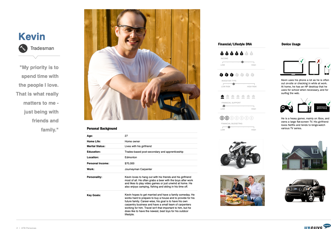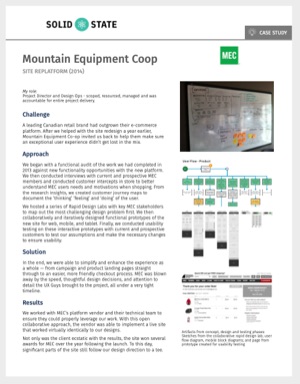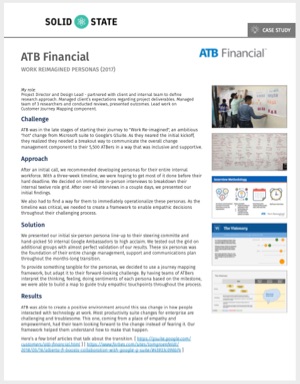Creativity is thinking up new things. Innovation is doing new things.
When I was at UX Guys, we always based our process and approach on decreasing risk for our clients and providing value for users. How can you possibly marry those concepts with creating innovative solutions? Read on to learn how we did it with ATB Financial and Whole Foods. The answer lies in just three simple words: investigate, collaborate, iterate
Here's five ways you find truly innovative solutions that address your business needs in a timely efficient manner.
1. Ensure there is a real business problem to solve
The key is having a business problem that will also provide opportunity for unmet user needs or where users are poorly served. Ensuring that all internal stakeholders agree on the priorities of the business problems that are trying to be solved is critical to the outcomes as well. This is the basis of product-market fit.
Example: The core business problem to be solved for Whole Foods was originally presented as “we need an app for our new loyalty program”. After sitting down to talk through the outcomes, we were able to help them see the actual business problem could be reframed as how do we incite incremental sales while satisfying their core value of “satisfying, delighting and nourishing their customers”. An app to serve as a loyalty program is about customer service. An app to make people eat more organic food: that’s really about changing behaviour.
Key Learning: Investigate internally, collaborate to understand and agree
2. Create an environment for many ideas “clues”
We used research and structured workshops to discuss opportunities.
 Example: For ATB, we did a combination of “guerilla” research and more traditional in-depth interviews (IDIs). Using the data and insights collected, we conducted structured brainstorming with the core group of business stakeholders and designers. Ideas were clustered and evaluated. As the business goal was to incite their target audience to save more money, behaviour design was also used as part of the evaluation. Alternative methods of ideation were used as well to ensure that we understood the full breadth of possibilities. The outcome of this was a short list of potential online products that intersected to satisfy the business problem and user needs.
Example: For ATB, we did a combination of “guerilla” research and more traditional in-depth interviews (IDIs). Using the data and insights collected, we conducted structured brainstorming with the core group of business stakeholders and designers. Ideas were clustered and evaluated. As the business goal was to incite their target audience to save more money, behaviour design was also used as part of the evaluation. Alternative methods of ideation were used as well to ensure that we understood the full breadth of possibilities. The outcome of this was a short list of potential online products that intersected to satisfy the business problem and user needs.
Key Learning: Collaborate efficiently and thoughtfully in ideation and iterate to uncover many possible outcomes
3. Perform triage based on the right criteria
Make sure you understand what constitutes a successful product-market fit for your project. Just “getting to market” isn’t good enough.
 Example: With ATB, we worked with the client team to subject each of the potential winners to a product-market fit test – in this case, the business model canvas. This addressed key outcomes of the project like who is the ideal customer, how will it be marketed, what channels, etc. This allowed the team to ensure that any of the potential product ideas that would be built could stand on their own as lines of business, and not just as a “stop gap” or “pet project”. Each project or company may have their own test of viability, this was the one that ATB chose.
Example: With ATB, we worked with the client team to subject each of the potential winners to a product-market fit test – in this case, the business model canvas. This addressed key outcomes of the project like who is the ideal customer, how will it be marketed, what channels, etc. This allowed the team to ensure that any of the potential product ideas that would be built could stand on their own as lines of business, and not just as a “stop gap” or “pet project”. Each project or company may have their own test of viability, this was the one that ATB chose.
Key Learning: Investigate viability before building anything, iterate on these models.
4. Define the group of “winners” and lightly prototype
 Design purpose-built lightweight personas and prototypes based on product-market fit assumptions that illustrate how the concept could work. Don’t sweat the small stuff, the idea is to prove out the concept, not design the ultimate solution.
Design purpose-built lightweight personas and prototypes based on product-market fit assumptions that illustrate how the concept could work. Don’t sweat the small stuff, the idea is to prove out the concept, not design the ultimate solution.
 Example: With Whole Foods, we ultimately created 5 concepts. The key is to not get caught up on the details, but to illustrate what the “hooks” are and how the app will flow. These prototypes don’t even have to be highly functional. For both of these projects, each of the initial concept prototypes for the apps were no more than half a dozen phone screens.
Example: With Whole Foods, we ultimately created 5 concepts. The key is to not get caught up on the details, but to illustrate what the “hooks” are and how the app will flow. These prototypes don’t even have to be highly functional. For both of these projects, each of the initial concept prototypes for the apps were no more than half a dozen phone screens.
Key Learning: Design collaboratively and focus on core concepts and illustrating high-level, not detailed interactions or even visual design.
5. Test iteratively and “competitively” until a winner emerges
Put the concepts in front of real users and let the best ideas win. Iterate daily (or quicker if feasible) and take the best ideas and merge them if possible.
 Example: For ATB, we created three concepts and iteratively tested them over three days. We embraced failing early and often and ditched the poor performers and improved the ones that passed for the next day. Remember to not hold on to things that don’t incite users attention or engagement. After the testing, concepts that are winners will emerge. We heard comments like “I think if this is real, I’m switching to ATB. I’d be all over this.” and “I like this because it is just cut and dry, add more, take less… When can I sign up for this?”
Example: For ATB, we created three concepts and iteratively tested them over three days. We embraced failing early and often and ditched the poor performers and improved the ones that passed for the next day. Remember to not hold on to things that don’t incite users attention or engagement. After the testing, concepts that are winners will emerge. We heard comments like “I think if this is real, I’m switching to ATB. I’d be all over this.” and “I like this because it is just cut and dry, add more, take less… When can I sign up for this?”
Key Learning: Daily iterations through testing ensure that the final outcome will reflect the best of all the inputs based on users’ needs and feedback
Last Word
By combining a clear business goal with understanding of your user, viable concepts can be evaluated consistently and efficiently. These ideas can then be easily tested, iterated, improved and validated without writing a line of code or waiting for a critical mass of market adoption. The best part of the entire approach? It only takes 12 weeks start to finish.
Originally published September, 2016
Additional Resources

MEC Redesign Case Study
How to create a brand new experience in weeks instead of months.
